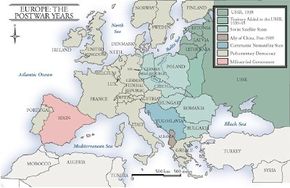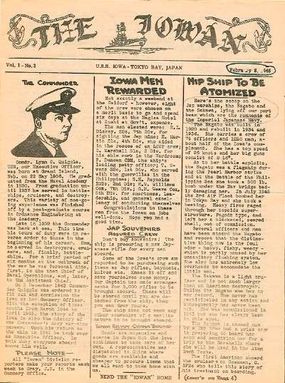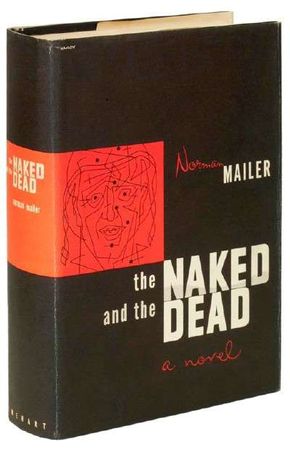The end of World War II opened the way for the building of a new world order. It was a very different order from the one Nazi Germany, Italy, and Japan had envisioned when they divided the world into spheres of influence in the Tripartite Pact of September 1940.
In the first place, the war proved to be a victory for European communism, which only a few years before -- as Nazi German forces bore down on Moscow -- had seemed close to defeat. Yet it was also a victory for Western liberal capitalism, as the Western Allies set out to secure free economies and parliamentary politics in Western Europe after years of economic crisis and political authoritarianism.
Advertisement
One of the few issues on which the wartime Allies could agree was the International Tribunal, which put Nazi German leaders on trial at Nuremberg for crimes against peace and for crimes against humanity. The trial opened in November 1945. In October 1946, all but three of the 22 defendants were found guilty.
The attempt to create a new framework of international law was compromised throughout by the knowledge that Stalin's Soviet Union was just as guilty of aggressive war and systematic violation of human rights. Nevertheless, the trials did promote a desire for a new international morality.
In 1948 the United Nations agreed on a convention outlawing genocide. A year later, a new Geneva Convention established clear rules for the conduct of war. And in 1950, the European Convention on Human Rights was established to protect human rights and fundamental freedoms.
On almost every other issue, the Soviet Union and the Western powers strongly disagreed. The future of Germany could not be settled, since neither side was prepared to see a reunited German state dominated by one of the two ideologies. In January 1947, the American and British zones of occupation were merged into Bizonia. Two years later, with the addition of the southern French zone, a separate West German state was created based on a democratic, federal constitution.
Stalin blockaded Berlin in 1948, which was situated in the Soviet zone but was jointly administered by the four occupying powers. Then, when the blockade proved ineffective (due to the Western Allies' airlift of supplies into the city), Stalin created a rival German Democratic Republic in the Soviet zone, run by a Communist-dominated regime. No formal treaty ending the war could be signed under these circumstances, and Germany remained partitioned.
The rest of the European continent was split between a capitalist west and a Communist east, divided by what Winston Churchill famously called an "iron curtain." When President Harry Truman announced in 1947 that the Western world would defend the right of free peoples everywhere who were "resisting subjugation," Stalin reluctantly accepted the division of the world into "two camps."
In 1947, U.S. secretary of state George Marshall convened a conference in Paris to draw up plans for financial aid to the struggling economies of Europe. The Soviet delegation responded by walking out when it became clear that aid would be forthcoming only if the Soviet Union agreed to international scrutiny of its economic policy.
Over the next two years, Communist regimes were confirmed in all the states of Eastern Europe occupied by the Red Army. Political pluralism was ended in those states, and Stalinist economies and police systems were imposed. In Yugoslavia, Josip Broz Tito succeeded in establishing the only Communist state independent of Moscow.
A savage civil war in Greece ended in 1949 with the defeat of the Communist insurgents. In Austria, a treaty allowed the creation of a nonaligned parliamentary state after 10 years of division into occupation zones.
In eastern Asia, the end of the war brought a long period of turmoil. In the European colonies occupied by Japan, liberation movements were established--some strongly Communist in outlook. In Indochina, Indonesia, and Malaya, wars were fought against the colonial powers as well as between rival factions.
The messy aftermath of war precipitated the final crisis of the old European imperialism; by the early 1950s, most of Southeast Asia was independent. In Burma and India, Britain could not maintain its presence. India was divided into two states in 1947, India (Hindu) and Pakistan (Muslim), and Burma was granted independence a year later.
Japan was not restored to full sovereignty until after the San Francisco Treaty was signed on September 8, 1951. The emperor was retained, but the military was emasculated and a parliamentary regime had been installed. Japanese prewar possessions were divided up. Manchuria was restored to China in 1946 (though only after the Soviet Union had removed more than half the industrial equipment left behind by the Japanese). Taiwan was returned to Chinese control. Korea was occupied jointly by the Soviet Union and the United States, and two independent states -- one Communist, one democratic -- were established there in 1948.
The most unstable area remained China, where the prewar conflict between Chiang Kai-shek's Nationalists and the Chinese Communists led by Mao Zedong was resumed on a large scale in 1945.
After four years of warfare, the Nationalist forces were defeated and Chiang withdrew to the island of Taiwan. The People's Republic of China was declared in 1949, and a long program of rural reform and industrialization was set in motion. The victory of Chinese communism encouraged Stalin to allow the Communist regime in North Korea to embark on war against the South in the belief that America lacked the commitment for another military conflict.
The Korean War began on June 25, 1950, when the troops of Kim Il Sung crossed the 38th parallel, the agreed-upon border between the two states. By this stage, the international order had begun to solidify into two heavily armed camps.
In 1949 the Soviet Union tested its first atomic bomb. That same year, the U.S. helped organize a defensive pact, the North Atlantic Treaty Organization (NATO), to link the major Western states together for possible armed action against the Communist threat.
By 1951 Chinese forces were engaged in the Korean conflict, exacerbating concerns that another world war -- this time with nuclear weapons -- might become a reality. The optimism of 1945 had, in only half a decade, given way to renewed fears that international anarchy and violence might be the normal condition of the modern world.
In the next section, see a timeline that details key post-World War II events that occurred in late 1945 and early 1946.
For more timelines and information on World War II events, see:



